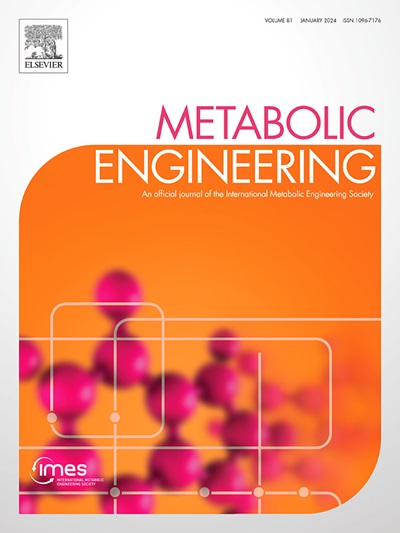High glutamate demand enables simultaneous consumption of glycerol and citrate despite carbon catabolite repression in engineered Bacillus subtilis strains
IF 6.8
1区 生物学
Q1 BIOTECHNOLOGY & APPLIED MICROBIOLOGY
引用次数: 0
Abstract
The increasing demand for biopolymers has positioned poly-γ-glutamic acid (γ-PGA) as a promising alternative to fossil-based polymers due to its biodegradability and biocompatibility. γ-PGA biosynthesis in Bacillus subtilis is closely linked to intracellular glutamate availability, which is typically maintained via the supply of an exogenous glutamate source, a cost-intensive factor for industrial production. This study investigates the metabolic interplay between glycerol, citrate, and glutamate during γ-PGA synthesis, focusing on how cellular glutamate demand influences carbon source utilization. We demonstrate that reducing exogenous glutamate supply induces demand-driven co-consumption of glycerol and citrate, which is usually inhibited by carbon catabolite repression. In the absence of exogenous glutamate, the B. subtilis strain PG10 produced 8.4 g L−1 γ-PGA, indicating significant de novo glutamate synthesis. A deletion analysis of known citrate transporters identified CimH as the key translocation system enabling citrate uptake under glutamate-limiting conditions. Further isotope labeling confirmed that citrate serves as a glutamate precursor during glutamate demand and is not used as a gluconeogenic substrate. Proteome analysis revealed a regulatory shift towards enhanced glutamate biosynthesis in the absence of exogenous glutamate, accompanied by reduced overflow metabolism and adaptive changes in central carbon and nitrogen metabolism. To our knowledge, carbon source co-utilization is a so far unknown response of B. subtilis 168 to glutamate scarcity. Uncovering the regulatory network involved offers a powerful tool by enabling biotechnological exploitation of this drastic change in carbon flux to boost the production of various products dependent on tricarboxylic acid cycle intermediates.
高谷氨酸需求使甘油和柠檬酸盐同时消耗,尽管碳分解代谢抑制工程枯草芽孢杆菌菌株。
随着对生物聚合物需求的不断增长,聚γ-谷氨酸(γ-PGA)因其生物可降解性和生物相容性而成为化石基聚合物的一个有前途的替代品。枯草芽孢杆菌中的γ-PGA生物合成与细胞内谷氨酸的可用性密切相关,而细胞内谷氨酸的可用性通常是通过外源谷氨酸的供应来维持的,这是工业生产的成本密集型因素。本研究探讨了γ-PGA合成过程中甘油、柠檬酸盐和谷氨酸之间的代谢相互作用,重点研究了细胞谷氨酸需求如何影响碳源利用。我们证明,减少外源性谷氨酸供应会导致需求驱动的甘油和柠檬酸盐的共同消耗,这通常被碳分解代谢抑制所抑制。在缺乏外源谷氨酸的情况下,枯草芽孢杆菌菌株PG10产生8.4 g L-1 γ-PGA,表明谷氨酸的重新合成显著。对已知柠檬酸转运体的缺失分析表明,CimH是在谷氨酸限制条件下实现柠檬酸摄取的关键转运系统。进一步的同位素标记证实,柠檬酸盐在谷氨酸需求期间作为谷氨酸前体,而不是用作糖异生底物。蛋白质组学分析显示,在缺乏外源谷氨酸的情况下,谷氨酸生物合成的调节发生了转变,并伴随着溢出代谢的减少和中心碳氮代谢的适应性变化。据我们所知,碳源共利用是迄今为止尚不清楚枯草芽孢杆菌168对谷氨酸缺乏的反应。揭示所涉及的调控网络提供了一个强大的工具,使生物技术能够利用碳通量的这种剧烈变化来促进依赖三羧酸循环中间体的各种产品的生产。
本文章由计算机程序翻译,如有差异,请以英文原文为准。
求助全文
约1分钟内获得全文
求助全文
来源期刊

Metabolic engineering
工程技术-生物工程与应用微生物
CiteScore
15.60
自引率
6.00%
发文量
140
审稿时长
44 days
期刊介绍:
Metabolic Engineering (MBE) is a journal that focuses on publishing original research papers on the directed modulation of metabolic pathways for metabolite overproduction or the enhancement of cellular properties. It welcomes papers that describe the engineering of native pathways and the synthesis of heterologous pathways to convert microorganisms into microbial cell factories. The journal covers experimental, computational, and modeling approaches for understanding metabolic pathways and manipulating them through genetic, media, or environmental means. Effective exploration of metabolic pathways necessitates the use of molecular biology and biochemistry methods, as well as engineering techniques for modeling and data analysis. MBE serves as a platform for interdisciplinary research in fields such as biochemistry, molecular biology, applied microbiology, cellular physiology, cellular nutrition in health and disease, and biochemical engineering. The journal publishes various types of papers, including original research papers and review papers. It is indexed and abstracted in databases such as Scopus, Embase, EMBiology, Current Contents - Life Sciences and Clinical Medicine, Science Citation Index, PubMed/Medline, CAS and Biotechnology Citation Index.
 求助内容:
求助内容: 应助结果提醒方式:
应助结果提醒方式:


